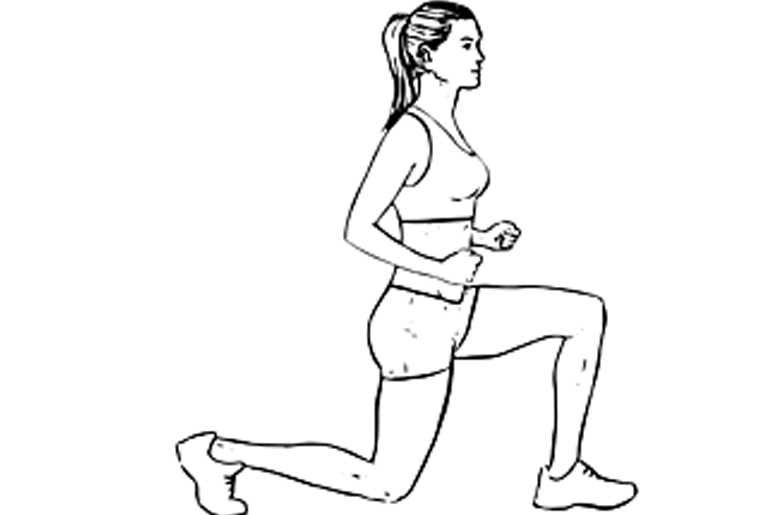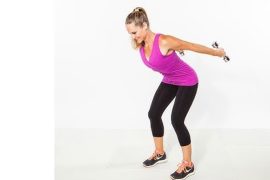If you’re looking to target your lower body, lunges are a go-to exercise known for building leg strength and improving balance. While the traditional forward lunge is popular, reverse lunges—where you step backward instead of forward—can be just as effective, offering added benefits like reduced strain on the knees and better control. This variation works the glutes, hamstrings, and quads while also engaging the core. To increase the intensity, you can incorporate weights such as dumbbells, making reverse lunges a versatile and powerful addition to any lower body workout routine.
Reverse lunges:
Reverse lunges are a lower-body exercise that involves stepping backward instead of forward, as seen in traditional lunges. According to fitness expert, this variation targets the glutes, hamstrings, and core muscles, making it a powerful move for improving strength and stability. Reverse lunges are widely used in both strength training and rehabilitation programs. Research published in Applied Sciences in 2024 highlights their potential therapeutic benefits, suggesting that reverse lunges may help delay mobility disability in individuals with Parkinson’s disease, making them not only effective for fitness but also valuable for functional health.
Benefits of Reverse Lunges:
- Strengthens Leg Muscles: Reverse lunges are excellent for targeting and strengthening key muscles in the lower body. By stepping backward, the exercise primarily engages the quadriceps (front thighs), hamstrings (back thighs), and glutes (buttocks). This makes it a powerful movement for building leg strength and endurance, improving overall lower body fitness.
- Reduces Joint Strain: One of the key advantages of reverse lunges over forward lunges is that they reduce strain on the knee joints. In forward lunges, the front knee absorbs more of the impact, whereas in reverse lunges, the weight is more evenly distributed across the body. This reduced pressure on the knee helps to prevent discomfort, making reverse lunges a gentler option. A study published in Physical Therapy Rehabilitation Science in 2021 also found that reverse lunges helped increase the range of motion in both the knee and ankle joints.
- Improves Balance and Coordination: Reverse lunges require significant core activation to maintain balance while stepping backward. This action helps to improve overall balance and coordination. By working on controlling backward movement, you strengthen the core muscles, which not only supports better posture but also improves functional coordination for daily activities.
- Supports Fat Loss: Reverse lunges are a calorie-burning exercise that helps with fat loss. By engaging large muscle groups, reverse lunges increase calorie burn and stimulate lean muscle growth. The activation of major muscle groups boosts the body’s metabolism, making reverse lunges a beneficial exercise for those looking to lose fat while toning the lower body.
- Enhances Mobility: This exercise is particularly beneficial for improving hip mobility. Reverse lunges help to stretch and strengthen the hip flexors, which can become tight due to prolonged periods of sitting. Increased hip mobility from regular reverse lunges can make common movements like walking, squatting, and climbing stairs easier and more fluid, enhancing overall functional mobility.
In summary, reverse lunges are a powerful exercise that not only strengthens the legs and glutes but also supports joint health, enhances balance and coordination, aids fat loss, and improves mobility, making them an excellent addition to any fitness routine.
How to Do Reverse Lunges
- Starting Position: To begin, stand upright with your feet placed hip-width apart. Ensure your body is straight to avoid slouching, which can lead to lower back pain. Keep your chest up and core engaged to maintain stability and balance throughout the movement.
- Step Back with Control: Take a big step backward with one leg, but avoid stepping too far back. A long step can place excessive strain on your knee and make it difficult to maintain your balance. The key is to step back with control, ensuring your body remains stable.
- Lower Your Back Knee: As you step back, lower your back knee toward the floor, but don’t let it touch the ground. Your front thigh should be parallel to the floor at the lowest point of the lunge. Keep your weight balanced on your front foot, ensuring the movement feels stable and controlled.
- Return to Starting Position: To return to the standing position, press through the heel of your front foot. This helps activate the glutes and hamstrings. Once you’re back in the starting position, repeat the movement on the opposite leg.
- Using Dumbbells (Optional):
For an added challenge, you can hold a dumbbell in each hand while performing the lunges. Start with a lighter weight, such as 2 kg dumbbells, to avoid wobbling and ensure proper form. This can help increase the intensity of the exercise.
Beginner’s Guidelines:
- Start with 3 sets of 10 reps per leg and rest for 30-60 seconds between sets.
- Perform reverse lunges 3-4 times a week to build strength and endurance.
- Gradually increase the number of reps as your strength improves.
- Reverse lunges are an effective exercise for strengthening the lower body, improving balance, and enhancing overall mobility.
Who Should Avoid Reverse Lunges
- Weak Knees: Can worsen knee pain.
- Poor Balance: May be difficult without support (use a wall or chair if needed).
- Lower Back Issues: Incorrect form can strain the lower back.
- Past Injuries: Avoid if you have ankle, knee, or hip injuries as it may delay recovery.
If you have any medical conditions, especially related to your knees, consult with a doctor before attempting reverse lunges.
Disclaimer:
The information contained in this article is for educational and informational purposes only and is not intended as a health advice. We would ask you to consult a qualified professional or medical expert to gain additional knowledge before you choose to consume any product or perform any exercise.







